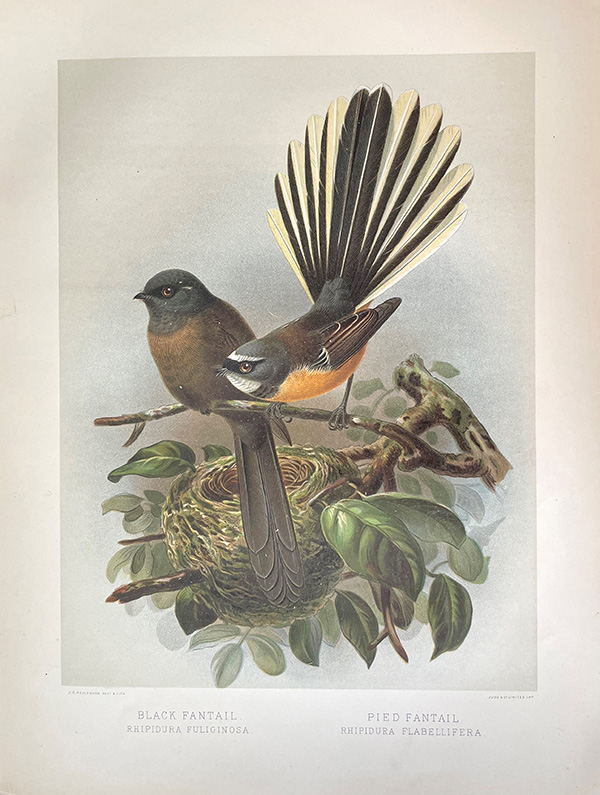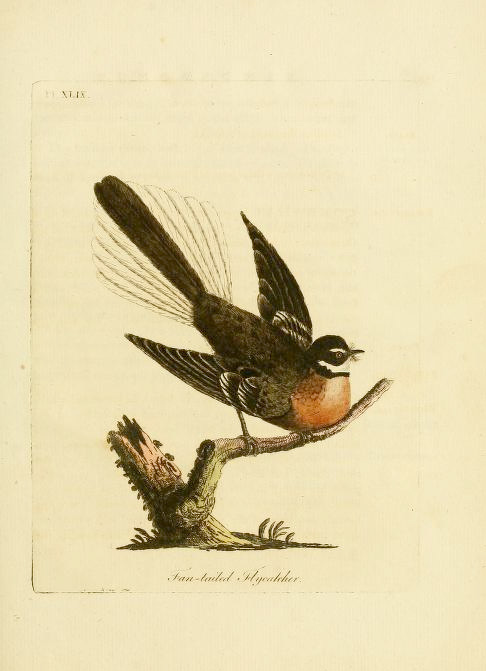


Piwakawaka, faintail from Buller's Birds of New Zealand, 1888.
The willows are budding which means, as every farmer knows, that the grass is growing. Spring is finally here and I have noticed that with the warmer mornings Piwakawaka, the fantail, is getting up early again.
I have been spending a lot of time over the winter, watching the fantails or, more precisely, worrying about them. How these tiny insect eating birds manage to survive the winter is a constant source of amazement to me. Depending upon the severity of the winter, many of course do not survive. This has been a mild winter so most of my birds here have managed to come through, whereas last winter was very hard on them. Nor did they breed here last year very successfully as it was cold and wet well into December.
But these wonderful little birds have developed strategies to survive, not the least of which is the ability, which they share with many other birds, to have several broods when the conditions are right so that even after a hard winter their numbers can increase very rapidly. Another strategy it seems is to get up late, very late, of a cold frosty morning. Around here they are not to be seen until after the sun has warmed the pastures and the little midges they feed on are active again.
A third strategy is the fantail’s clever choice of sites to roost at night. The bush used to provide dense warm cover for the forest birds before introduced deer, pig and goats cleared away the understory. Now Piwakawaka has made its adaptions and a favoured site for one pair here is a large pampas bush growing on a hillside in the lee of the southerly wind, and which gets the first rays of the morning sun. They tuck themselves deep into this bush and only emerge when the sun rises. Another couple has found a wonderful roost between the black polythene covered stacks of haysilage, a spot that would be very warm indeed.
However, it is not just fantails which take so much trouble in finding sites to roost at night. What makes a good roosting site for birds? What influences their choices?
First the roost must provide protection from predators when the bird is asleep and relatively unresponsive to danger. Many species roost in dense cover, including some ground dwellers such as pheasants while most hole nesting birds roost in holes. Other birds such as skylarks roost in open ground, relying on spotting an approaching predator before it finds them.
The second vital function of a roost, especially critical for fantails, is to provide warmth and shelter from the weather. Fluffing out feathers improves insulation but birds can also reduce heat loss appreciably by roosting in some kind of shelter. Bushes, trees and other cover can help maintain the body temperature by those few vital degrees. Some birds have learned to roost in towns where the average temperature may be higher than in the countryside.
Though some birds such as dunnocks and thrushes roost alone, many birds, from waders and gulls to starlings, gather together at night in large communal roosts for at least part of the year. Around here it is the sparrows and the finches that roost together in favoured avocado trees, once again the trees on a slope in the lee of the southerly winds.
They huddle together in such roosts for warmth, the most dominant birds taking the centre positions, forcing the immature and more subordinate to the edges where they are at the mercy of the elements. Another advantage of communal roosts may be to gain extra protection from predators, the chance being that some birds will not be sleeping so deeply and can warn others.
The most intriguing idea advanced by recent research to explain communal roosting is that in some species, such as starlings, the roost may serve as an information centre, enabling birds to share, among other things, information on better food supplies.
So it will be interesting to see if the idea grows and my fantails’ trick of roosting between the haysilage bales will be passed on to others of their kind.
Narena Olliver — Waiotahe Valley, Eastern Bay of Plenty, 1997.


Faintail from Latham's A General Synopsis of Birds, London, 1795.
| Taxonomy | |
|---|---|
| Kingdom: | Animalia |
| Phylum: | Chordata |
| Class: | Aves |
| Order: | Passeriformes |
| Family: | Monarchidae |
| Genera: | Rhipidura |
| Species: | fulginosa |
| Sub Species: | placabilis, fuliginosa, penitus |
Pied fantail, tiwakwaka, grey fantail.
Native bird
16 cm., including long fanned tail, 8g., pied bird hs grey head, white eyebrow, brown back, yellow underparts, black and white tail., juvenile similar but browner body; black phase, sooty black but for white spot behind the eye.
Widespread, from bush to gardens.
Song of: — Piwakawaka, the fantail
Viking Sevenseas
»»» Fantail
Poetry: —
See! In the Kauwae-Raro,
O small dancing bird,
Old Kupe says you touched him,
We have his stately word.
And what said Kupe of you,
O small bird of grace?
He said: “The Tiwai Waka
Kept flitting past my face!”
O little Tiwa Waka,
O kind little wing!
I've seen a woman hunt you,
With haste and muttering.
She said it was unlucky,
She drove you out with cries,
For when a fantail flies within
A son or neighbour dies.
Unlucky! It's an honour,
A bird flying through.
He had the whole sweet countryside,
And yet he came to you.
— Eileen Duggan
Walter Lawry Buller, A History of the Birds of New Zealand, 2nd ed., 1888.
Latham, John, A General Synopsis of Birds, London, 1795.
Heather, B., & Robertson, H., Field Guide to the Birds of New Zealand, 2000.
Oliver, W.R.B., New Zealand Birds, 1955.
Saturday, 8 October, 2023; ver2023v1